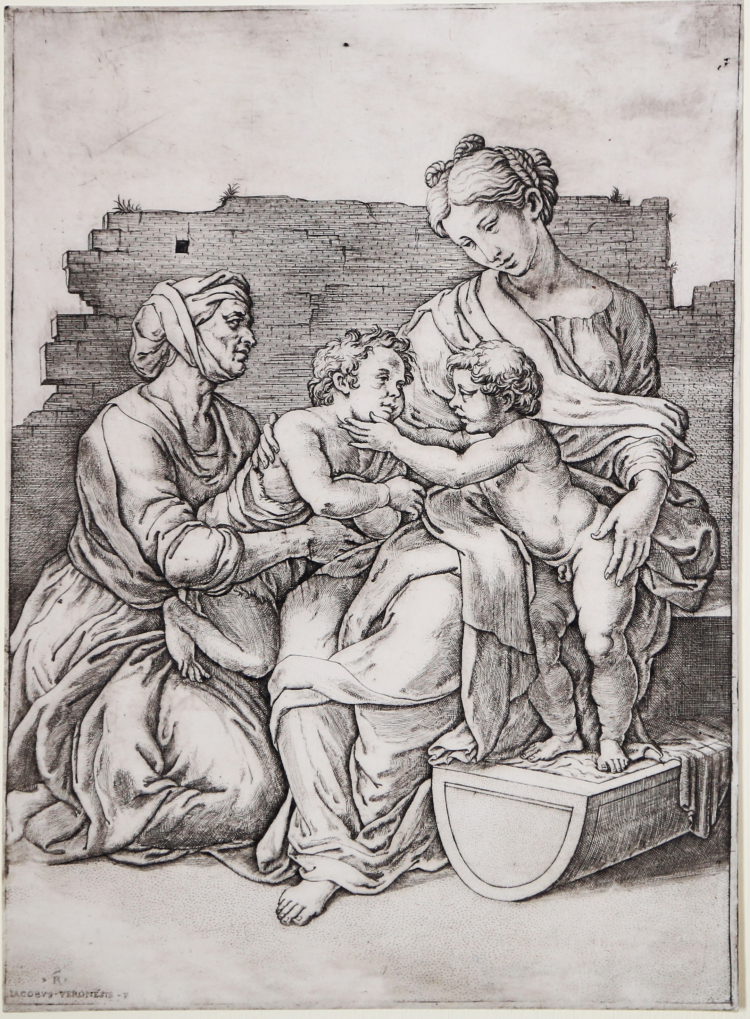




| Reference: | S30168 |
| Author | Gian Jacopo CARAGLIO |
| Year: | 1535 ca. |
| Measures: | 220 x 305 mm |



| Reference: | S30168 |
| Author | Gian Jacopo CARAGLIO |
| Year: | 1535 ca. |
| Measures: | 220 x 305 mm |
Engraving, circa 1530, signed at lower left R / IACOBUS VERONESIS F. After Giulio Romano. Example in the third finale state, with the cradle completed.
A fine impression, rich of tone, printed on contemporary laid paper with “star in a circle” watermark, trimmed to the platemark, in perfect conditions.
The work reproduces the composition of the so-called Small Holy Family (1518-19), a painting in the Louvre and attributed to Raphael in the past but now assigned to Giulio Romano and Giovanni Francesco Penni. However, it could also result from an anonymous drawing at Windsor Castle (RCIN 912740), in red chalk, with stylus underdrawing.
Ruland (The works of Raphael Santi da Urbino as represented in the Raphael collection in the Royal Library at Windsor Castle, 1876, p. 80, XXXIX, no.6) classed this drawing as by Raphael in 1876, but most other earlier scholars (including Popham in A.E. Popham & J. Wilde, The Italian Drawings of the XV and XVI Centuries in the Collection of His Majesty The King at Windsor Castle, 1949, no. 833) dismissed it as a copy. Competing claims of attribution between Raphael and Giulio Romano have been debated in more recent scholarship, but it has been usual to attribute both painting and drawing to the latter.
The engraving is signed IACOBUS VERONESIS F and with the initial R, presumably to credit Raphael with the invention.
A magnific example.
Bibliografia
Bartsch XV, p. 69, 5; TIB, p. 87, 005 III/III; Massari, Giulio Romano, p. 62, 53; Passavant VI, p. 96, 5; Massari, Raphael Invenit, p. 207, XXXIX.
Gian Jacopo CARAGLIO (Verona 1505 - Cracovia 1565)
|
Giovanni Jacopo Caraglio or Caralio, Caral, Caralius, was a copper engraver, gem cutter, goldsmith and maybe even architect, according to Vasari. Caraglio was born approximately in 1505, in Verona or Parma, that is the reason why he often refers to himself as Veronensis or Parmensis. Because of the Sack of Rome he was obliged to leave unfinished his Ratto delle Sabine (The Rape of the Sabine Women), after a drawing of Rosso Fiorentino. He moved to Venice, were he worked until 1537.
While in Rome, he worked for Baviera, realizing in 1562 Dei dell’Olimpo, Fatiche di Ercole and Amori degli Dei, all after Rosso’s drawings, his favourite artist, together with Baldinelli and Parmigianino. While in Venice, on the contrary, he worked on subjects from Titian.
He moved to Poland in 1539 and started spreading the graphic art of Marcantonio in the Eastern Countries.
On July the 3rd, 1545, he joined the Court of Siegmund II, with an annual salary of 60 florins, till the death of the King in 1548; he afterwards worked for King Siegmund II Augustus as goldsmith and gem cutter. In 1552 he’s said to be working in Vilna, in Lithuania, the second capital city of the kingdom where the Court had temporarily moved. He went back and forth from Italy to Lithuania untill he died, on August the 26th, 1565.
Bartsch has listed 65 engravings belonging to Caraglio; Le Blanc has added other four subjects.
|
Gian Jacopo CARAGLIO (Verona 1505 - Cracovia 1565)
|
Giovanni Jacopo Caraglio or Caralio, Caral, Caralius, was a copper engraver, gem cutter, goldsmith and maybe even architect, according to Vasari. Caraglio was born approximately in 1505, in Verona or Parma, that is the reason why he often refers to himself as Veronensis or Parmensis. Because of the Sack of Rome he was obliged to leave unfinished his Ratto delle Sabine (The Rape of the Sabine Women), after a drawing of Rosso Fiorentino. He moved to Venice, were he worked until 1537.
While in Rome, he worked for Baviera, realizing in 1562 Dei dell’Olimpo, Fatiche di Ercole and Amori degli Dei, all after Rosso’s drawings, his favourite artist, together with Baldinelli and Parmigianino. While in Venice, on the contrary, he worked on subjects from Titian.
He moved to Poland in 1539 and started spreading the graphic art of Marcantonio in the Eastern Countries.
On July the 3rd, 1545, he joined the Court of Siegmund II, with an annual salary of 60 florins, till the death of the King in 1548; he afterwards worked for King Siegmund II Augustus as goldsmith and gem cutter. In 1552 he’s said to be working in Vilna, in Lithuania, the second capital city of the kingdom where the Court had temporarily moved. He went back and forth from Italy to Lithuania untill he died, on August the 26th, 1565.
Bartsch has listed 65 engravings belonging to Caraglio; Le Blanc has added other four subjects.
|